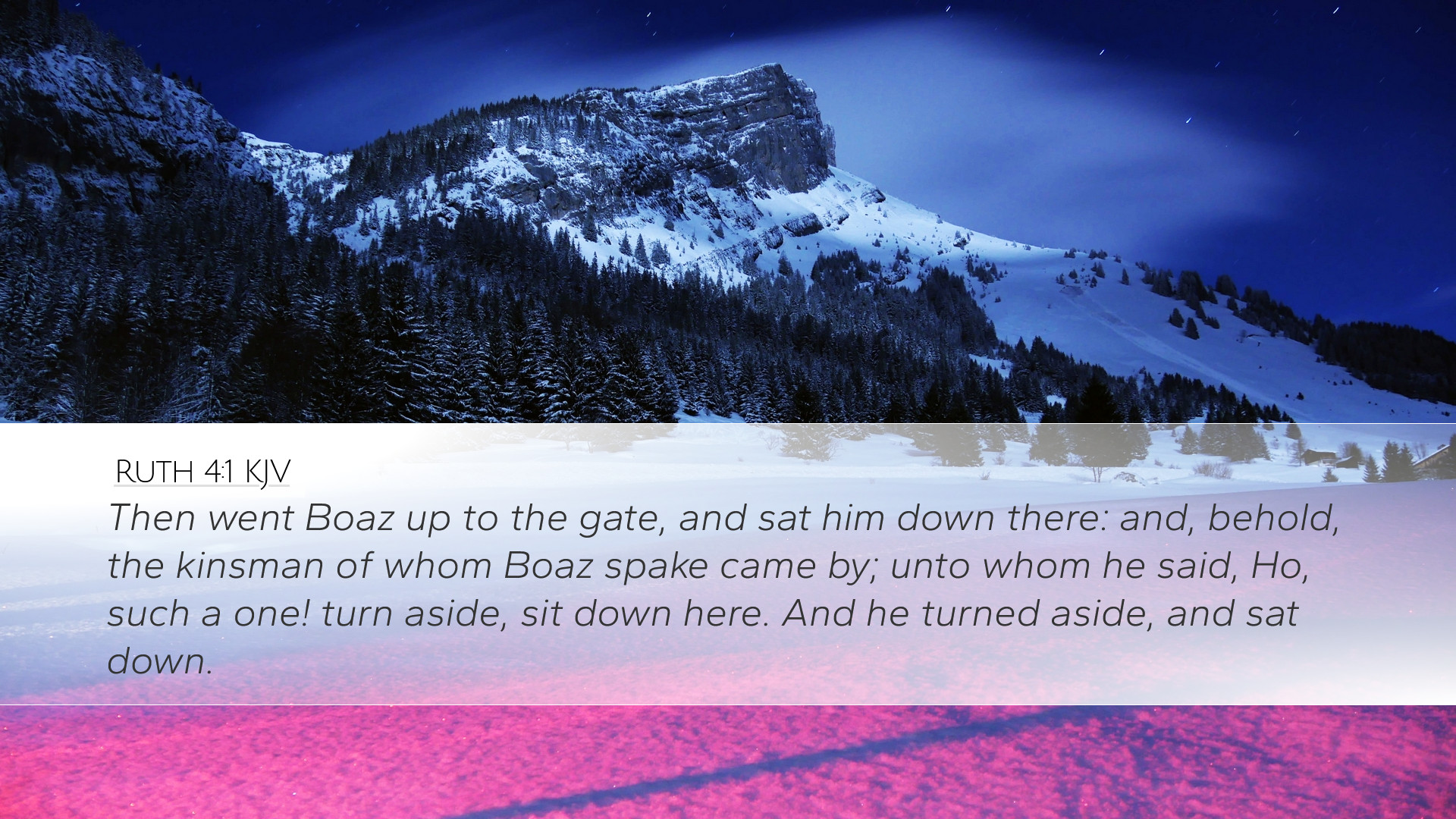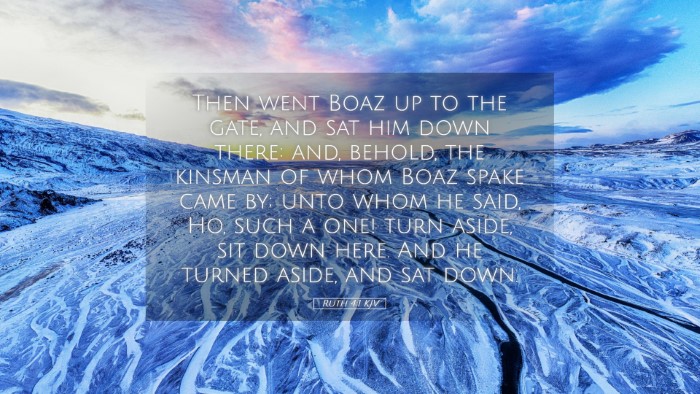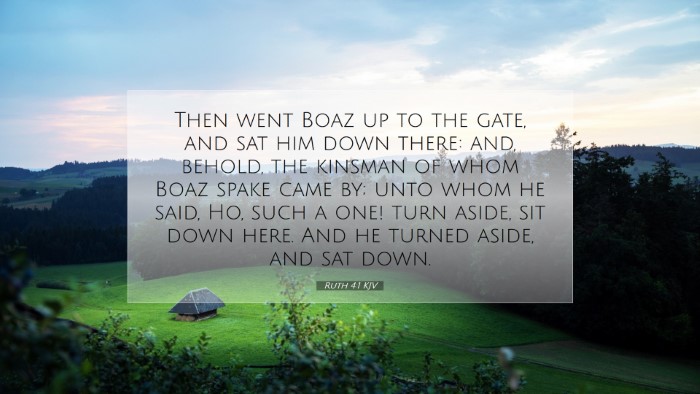Old Testament
Genesis Exodus Leviticus Numbers Deuteronomy Joshua Judges Ruth 1 Samuel 2 Samuel 1 Kings 2 Kings 1 Chronicles 2 Chronicles Ezra Nehemiah Esther Job Psalms Proverbs Ecclesiastes Song of Solomon Isaiah Jeremiah Lamentations Ezekiel Daniel Hosea Joel Amos Obadiah Jonah Micah Nahum Habakkuk Zephaniah Haggai Zechariah MalachiRuth 4:1
Ruth 4:1 KJV
Then went Boaz up to the gate, and sat him down there: and, behold, the kinsman of whom Boaz spake came by; unto whom he said, Ho, such a one! turn aside, sit down here. And he turned aside, and sat down.
Ruth 4:1 Bible Commentary
Ruth 4:1 - Commentary Overview
Ruth 4:1 stands as a pivotal moment in the narrative of the Book of Ruth, illustrating themes of redemption, loyalty, and divine providence. This verse introduces the formal procedure of acquiring land and fulfilling familial duties, emphasizing the cultural significance of the kinsman-redeemer within Israelite society.
Text of Ruth 4:1
"Then went Boaz up to the gate and sat him down there: and, behold, the kinsman of whom Boaz spake came by; unto whom he said, Ho, such a one! turn aside, sit down here. And he turned aside, and sat down."
Context and Significance
This verse occurs after Ruth's declaration of loyalty and the gathering of evidence for her claim to Naomi's deceased husband's estate. The gate of the city is a place of judgment, community decisions, and legal transactions among the Israelites, demonstrating Boaz's integrity and faithfulness to the Law.
Commentary Insights
Matthew Henry's Commentary
Matthew Henry notes that Boaz's actions epitomize his character as a righteous man. By going to the gate, he demonstrates his commitment to fulfilling the law regarding the redemption of land and family ties. He emphasizes the public nature of this transaction, ensuring that it is conducted with transparency and accountability.
Albert Barnes' Notes
Albert Barnes contextualizes this narrative by explaining that the gate was a significant place where legal and social matters were settled. He highlights the immediate need for Boaz to act, noting that the arrival of the nearer kinsman (as referenced) introduces a tension crucial for unfolding the redemptive storyline. Barnes elaborates that Boaz's proactive approach not only shows his readiness to redeem Ruth and Naomi but also reflects God's providential timing in orchestrating events for His purposes.
Adam Clarke's Commentary
Adam Clarke delves deeper into the cultural practices concerning redemption. He explains that the kinsman-redeemer had the duty to purchase land and provide for the widow, thus preserving the family lineage. Clarke expounds on the honor and selflessness that characterize Boaz, underlining his desire to fulfill this duty with proper decorum. He also reflects on the astonishing coincidence of meeting the nearer kinsman at the gate, attributing it to divine orchestration.
Theological Implications
The themes of redemption and providence in Ruth 4:1 are rich for theological reflection.
- The Role of the Kinsman-Redeemer: This passage embeds the concept of the kinsman-redeemer in Israelite law, yet it serves as a foreshadowing of the ultimate Redeemer, Jesus Christ, who redeems humanity from sin.
- Divine Providence: The circumstances leading to Boaz’s encounter with the kinsman reveal God’s sovereignty and perfect timing. Pastors and theologians can draw parallels to how God orchestrates events in believers' lives today.
- Community and Accountability: The public setting of the city gate emphasizes the importance of community in decision-making and accountability. This serves as a reminder of the communal aspects of faith and legal matters in the life of believers.
- Loyalty and Commitment: Ruth’s loyalty to Naomi and Boaz’s commitment to follow the law provide a model of covenantal relationships that can inspire pastoral care and community-building within the church.
- Gender Roles in Scripture: The actions of Ruth and Naomi challenge conventional gender roles, showcasing the significance of women’s agency in biblical narratives and their active roles in God’s plan.
- Hope and Restoration: This moment in the narrative encapsulates a transition from despair to hope, illustrating how God brings restoration in difficult circumstances, a vital truth for pastoral counseling.
- Legal and Spiritual Dimensions: The intersection of legal responsibilities with spiritual calling in this verse serves as a basis for exploring the relationship between faith and works from a scriptural perspective.
- Faith in Action: Boaz's initiative to seek the nearer kinsman reminds believers to act in faith and not wait passively for change, a relevant lesson in discipleship and service.
- Legacy of Faithfulness: Ultimately, the legacy of Ruth and Boaz in this narrative is significant; their faithfulness and obedience to God's guidelines bring forth a lineage that culminates in Jesus, enriching the understanding of family and faith across generations.
Application for Pastors and Theologians
The richness of Ruth 4:1 encourages pastors and theologians to explore the multifaceted dimensions of redemption present in Scripture. It invites them to reflect on the practical applications of kinsman-redeemer principles in modern ministry and community life. The themes of loyalty, divine intervention, and community responsibility present a template for preaching and teaching that resonates deeply with congregational life today.
Conclusion
In summary, Ruth 4:1 encapsulates a critical juncture in redemptive history, tying together themes of law, community, and divine providence. Drawing from multiple public domain commentaries, this exploration underlines the importance of understanding this text not only in its immediate context but also in its broader theological implications, for both historical and contemporary faith communities. This moment encourages believers to recognize and participate in God's redemptive work, emulating the steps of Boaz as they navigate complex life circumstances.


